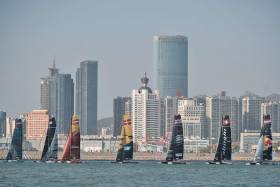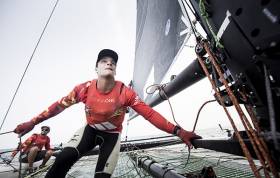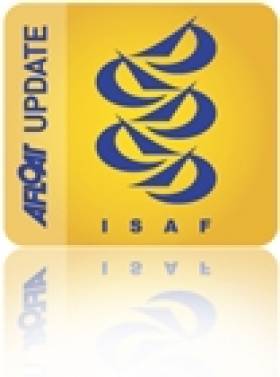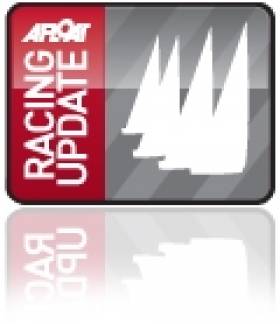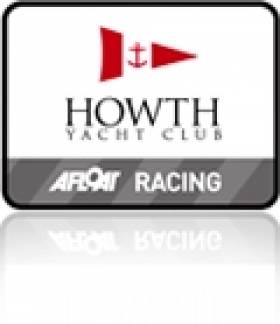Displaying items by tag: Shane Diviney
Howth's Shane Diviney Claims RORC Caribbean 600 Title on Pac52 Warrior Won
The overall winner of the 13th edition of the RORC Caribbean 600 is Christopher Sheehan’s Warrior Won (USA) where Howth Yacht Club's Shane Diviney of Sutton on Dublin Bay was part of the Pac52 crew.
None of the teams still racing under IRC has any realistic chance of beating Warrior Won after time correction.
Christopher Sheehan and his team will be presented with the RORC Caribbean 600 Trophy at the Prize Giving tonight.
 The overall winner of the 13th edition of the RORC Caribbean 600 is Christopher Sheehan’s Pac52 Warrior Won (USA) Photo: Robert Hajduk
The overall winner of the 13th edition of the RORC Caribbean 600 is Christopher Sheehan’s Pac52 Warrior Won (USA) Photo: Robert Hajduk
Christopher Sheehan, owner and skipper of Warrior Won is from the Larchmont Yacht Club, USA. Sheehan’s Warrior Won was taking part in its first RORC Caribbean 600, having won the 2022 Transpac Race overall.

“I feel so much joy right now. It is very humbling when I think about all of the competitors that have worked so hard in this race, I am overwhelmed. We have been preparing for this race for the last eight months and when I think of the great teams that have won this race, it is just extraordinary. The mantra of Warrior Won is humility and extreme confidence in what we are doing, which results in positive energy on board, hard work and collaboration. Every member of the Warrior Won team has put in an outstanding performance.”
 Christopher Sheehan, owner and skipper of Warrior Won is from the Larchmont Yacht Club, USA Photo: Arthur Daniel/RORC
Christopher Sheehan, owner and skipper of Warrior Won is from the Larchmont Yacht Club, USA Photo: Arthur Daniel/RORC
Richard Clarke, Tactician on Warrior Won is a four-time Olympian for Canada and a Volvo Ocean Race winner: “A race like the Caribbean 600 is short but complicated, it’s short enough that you can push really, really hard, but you have to manage fatigue. On Warrior Won with a fixed keel you have to keep as many bodies on the rail as you can. The basic aspects are keeping the boat at maximum speed with the right combination of sails up. As a tactical race the ‘600 rates as one the hardest in the world because there are so many islands to round and the tactics vary according to the time of day. Add fickle trade winds and squally clouds into the mix, I equate this to going ten rounds in a boxing match, where the left and the right and the combinations just keep coming at you. Sometimes you have to play offence or defence, because at any moment you can park-up, so no lead is safe until you finish.”
Chris ‘Lew’ Lewis - Navigator on Warrior Won is an amateur sailor working in the tech industry in San Francisco: “We spend a lot of time preparing for this race, going through the tracks of some of the great navigators that have taken part in this race. The Warrior Won team has instituted a two and a half year testing programme, so we know at every given angle and every given wind strength what the best sail combinations are, and after that it is all about execution. With an incredible crew, every time we needed to change sail it would magically appear. Getting ready for a big race like this is everything for me. While the professionals have to allocate their time between one race and the next, I do relatively few races and I have been working on just this race for a long time. To win this bucket-list race is a dream come true. I have not caught up on my sleep yet, so maybe I am still dreaming.”
Christopher Sheehan’s Warrior Won has an exciting programme of races which will include the 2022 Rolex Sydney Hobart, the 2023 Rolex Fastnet Race and Rolex Middle Sea Race. In 2024 Warrior Won will race back to the Caribbean in the 2024 RORC Transatlantic Race.
Warrior Won Crew: Christopher Sheehan, Thomas Allin, Stuart Bannatyne, Norman Berge, Richard Clarke, Shane Diviney, Scott Ewing, Gregg Griffin, Morgan Gutenkunst, Hartwell Jordan, Collin Leon, Chris Lewis, Tristan Louwrens, Henry Vogel, Christopher Welch.
#ExtremeSailing - ‘Marine Formula 1’ is how the high-performance vessels of the Extreme Sailing Series are being described in Qingdao, China, where the fleet has amassed this weekend for the Mazarin Cup.
It marks the second stage of the 2017 edition of the series that since 2007 has brought together round-the-world yachtsman, America’s Cup veterans, Olympic medallists, world record holders and other elite sailors to race speedy and nimble foiling GC32 catamarans within a stadium environment.
Among them is Howth Yacht Club’s own Shane Diviney, who crews skipper/helm Chris Steele’s NZ Extreme team as headsail trimmer.
No stranger to the series, Diviney spoke to Afloat.ie last September about his experience with Steele’s previous team CHINA One and the wildcard Gazprom Team Russia.
“The Extreme Sailing Series is the most challenging racing for the crews I have done,” he said.
You can follow Diviney and the rest of the fleet in action with live streams on the official YouTube channel.
Howth Yacht Club's Shane Diviney is Extreme Sailing on Gazprom Team Russia
Afloat.ie caught up again with Howth Yacht Club's Shane Diviney, the only Irish sailor racing on the Extreme Sailing Series in Russia where the pro match-racer is onboard Gazprom Team Russia instead of his regular China One team.
You are here in St Petersburg racing with Gazprom Team Russia. How has that been?
I was able to join Gazprom Team Russia for the Extreme Sailing Series for the St. Petersburg Act because my usual team, China One, are not doing this event. This is Gazprom Team Russia’s debut event on the Extreme Sailing Series for 2016 and we are representing the St. Petersburg Yacht Club as the local entry for this event. I think the team has gelled really well considering we have never sailed together as a team. We have shown that we can mix it up with the more established teams on this tour. We were happy with our speed and have identified the areas where we need to improve.
You have done a few ESS events now. What is the best thing about the Series in your opinion and what is so appealing about the circuit?
The Extreme Sailing Series is the most challenging racing for the crews I have done. The race course is always so short and usually confided by numerous physical boundaries, although we do get the chance to do some open water racing at some events, which is also great. With the GC32s travelling at such high speeds you are never going in a straight line for more than a couple of minutes. This puts a big emphasis on your manoeuvres and often the teams that have the slickest and least amount of manoeuvres will be in the top 3. The highly challenging racing makes this circuit attractive to both the sailors and the spectators.
What can you tell us about the competition? Which are the strongest teams and why?
Oman Air and Alinghi have proved to be the boats to beat all season. The top teams always try to keep the racing uncomplicated and reduce the potential for error. There are always big gains to be made around the race course if you can manage to get your boat in clear air and reduce the amount of manoeuvres. This is what we have strived to achieve this week on Gazprom Team Russia here this week.
What is for you next after the St Petersburg Act?
My next regatta will be in Sotogrande (Spain) with Team Armin Strom sailing in the GC32 Racing Tour. We are currently sitting 3rd overall in that series so we will be hoping to consolidate our podium position in the final two events of the season. After this, I will hopefully be going to Lisbon for the Act 7 of the Extreme Sailing Series.
Shane Diviney from Howth Yacht Club represents Irish sailing interests at the Extreme Sailing Series this weekend in Cardiff. The unique global professional racing circuit visits eight countries in ten months where seven international crews compete including the Dublin born pro-sailor Diviney.
Diviney (25) has clocked up a lof of professional experience in many sailing circuits (see CV below) but this is his first inclusion in the Extreme Sailing Series where he races with the Chinese flagged team.
- Shane's role with China One for the Extreme Sailing Series:
"I am part of the sailing team with China One. I was trimming in Act 1 and 2 in Muscat and Qindago. In Cardiff I am filling in on the bow for Chris Steele who is injured. Doing bow on the GC32 involves trimming the board rake on the foils which controls our flight."
- What it means to Shane to be part of the team and the Series:
"It is exciting to be involved in a Series that I have followed for many years. 2016 was a great year for China One to join the ESS with the move to the foiling GC32 boats. These boats are at the forefront high performance racing at the moment and I feel very lucky to be involved in this new style of sailing."

Shane competing in China One (left) yesterday in Cardiff. Photo: Mark Lloyd
- Why is the Extreme Sailing Series different to other sailing events Shane has been involved with:
"The racing in the Extreme Sailing Series is very much geared towards spectator friendly sailing, with racing always taking place very close to shore and very little sea room in which the race course can be laid. In some venues such as Cardiff it is not possible for the race committee to set a traditional windward/ leeward race course given the usual wind direction. Therefore they have to get creative with the race course. I find it refreshing to do these more unusual course formats when we are used doing standard windward/ leeward courses in most other racing. Racing close to land also means that the breeze is usually very gusty and shifty which can make things interesting when you have 8 foiling boats meters apart doing 30+ knots."
Shane's CV:
- Born in Dublin on 20.05.91
- Ireland and New Zealand Match Racing champion
- 1st Class 0 2015 Sydney to Hobart Yacht Race
- 3rd 2015 GC32 Riva Cup - Lake Garda
- 1st 2015 Warren Jones Youth International
- 2nd Youth European Match Racing Champs
Irish Compete at Royal Southern World Match Racing Tour
#wmrt – Held between the 10-14th of June in a wide range of conditions on the Solent. Day One saw probably the most consistent breeze, with day two and four cut short due to a lack of wind and day three experiencing too much.
Despite this, the race committee completed a full round robin along with semi finals and full decider matches for the top 6 teams.
This years Grade 2 regatta had the added bonus of being part of the World Match Racing Tour, with points awarded to the top 6 teams towards the overall world championship series.
Several Irish competitors were involved including Philip Bendon's team, who had a tough week.
The two regular Irish crew members aboard Mark Lees's GBR Match Racing- Howth's Scott Flanigan and Shane Diviney were joined this week by fellow club mate Eamonn Bourke in an almost all Irish team!
After a slow start to the event, Lees's team sailed an almost flawless day two and three losing only to Ian Williams (Team GAC Pindar) to finish the round robin tied for 3rd place. This form was continued in the semi final against Williams were they lost 3-2, having taken it to the full 5 matches following the only defeats experienced by the 5 time and reigning World Champion.
Williams went on to win the final 2-0 against the promising Redline Racing team from Perth skippered by Matthew Jerwood.
Another Top 4 finish at the Royal Southern continues a string of good results for the GBR match racing team having also placed 2nd at last weeks Grade two in Helsinki, as they build towards a tour card spot on the World Match Racing Tour. They currently lie 10th on the overall standings, with Jerwood's team the current leaders.
Howth Yacht Club Sailors on World Match Racing Tour
#wmrt – The World Match Racing Tour sees a new expanded schedule for the 2015/16 Season. The tour now consists of two levels of competition. Along with the usual 7 World Championship events the tour now includes a number of smaller competitions which are scored at half points but count towards the overall World Match Racing Tour Standings. Howth sailors Shane Diviney and Scott Flanigan have been competing in the first three regattas of the 2015/16 World Match Racing Tour season. It's another Irish dimension the tour that already sees Cork Match Racer Philip Bendon contest World Match Racing Tour on the Hamble.
Having narrowly missed out on selection for a tour card Diviney and the 36 Below Racing Team, with skipper Chris Steele of New Zealand headed to Long Beach California to compete in the Ficker Cup in early May. The event was a qualifier for the prestigious Congressional Cup to be held the following week. With the top two teams from the Ficker Cup qualifying for the Congressional Cup the objective was clear. The eight teams completed a double round robin in the fleet of evenly matched Catalina 37's. After two days of racing 36 Below Racing came out on top of the qualifying series only losing 2 of their 14 matches. They went on to win their semi-final 2-0. With a berth in the Final awaiting the team were relieved to be assured at least a top two finish and an entry to the Congressional Cup. The final saw the team come up against the local favourite Dustin Durant and his Long Beach Match Racing Team. Their experience in the Catalina 37's was not enough to overcome Steele and his 36 Below Racing team and they went on the win the finals 2-0 and take the Ficker Cup.
The Congressional Cup saw a big step up in the level of competition with most of the World's Top Match racers in attendance, including current World champion Ian Williams and defending Congressional Cup champion, Taylor Canfield. Racing was held just off the end of Long Beach Pier which attracted a big crowd of spectators each day. 36 Below Racing had a strong start to the regatta winning 4 from 5 on the first day of racing. They went on the finish the round robin in 6th position with a record of 6-5 which guaranteed them a spot in the quarter finals. The team came up against fellow Kiwi Phil Robertson in the quarterfinal. Phil sailed three perfect races to take the series 3-0. Although disappointed not to make the semi-finals the team were pleased with their performance in a competitive field. The event was eventually won by Taylor Canfield who beat Robertson 2-1 in a close final.
The World Match Racing Tour then moved to Langenargen, Germany with Scott Flanigan and Shane Diviney joining Mark Lees and his team from the U.K who received a wild card entry to the event. The regatta is known for its light and shifty race course making it extremely challenging to get the heavy Bavaria 40's around the course. The team made an impressive start to their first World Match Racing Tour event with a strong showing in the round robin with a score of 6-5. This left them in 6th place and gave them a spot in the quarter finals. They came up against the very experienced team of Eric Monin and his crew from Switzerland. Monin's experience prevailed as he did a better job of keeping the boat moving around the very light race track to take the series 3-0 in front of a spectator packed lake front. He went on to take second place at the regatta. The team were satisfied with their showing and finished a very credible 6th place.
It is only the beginning of a very busy season for both teams as they prepare to compete in a number of international regattas over the coming months.
#hyc – Howth Yacht Club's (HYC) Shane Diviney, a former Dublin City University student now based in Australia, was on pit duty for Chris Steele's winning 36 below team in Perth for the Warren Jones Youth Regatta this week.
Steele and his crew from the Royal New Zealand Yacht Squadron beat local skipper Sam Gilmour on a count back after racing in the final was curtailed by light winds.
Steele and his crew of Hamish Hardy, Shane Diviney, Josh Salthouse and Harry Hull were challenged all the way in the testing conditions, being taken to a third race in the quarter-finals by Japan's Kohei Ichikawa. Then in the semi-finals it was Australia's Lachy Gilmour who took them to three races, before he needed a count back to win the final.
The Warren Jones Regatta was hosted by the Royal Perth Yacht Club, and run by Swan River Sailing, and is for sailors under the age of twenty five. The trophy was given in memory of Warren Jones, who was the driving force behind Australia II's famous victory in the America's Cup in 1983.
Overall Results:
1 Chris Steele (Royal New Zealand Y.S.)
2 Sam Gilmour (Royal Freshwater Bay Y.C.)
3 Henry Kernot (Jay Griffin) (Cruising Y.C. of Australia)
4 Lachy Gilmour (Royal Freshwater Bay Y.C.)
5 Matt Jerwood (South of Perth Y.C.)
6 Joachim Aschenbrenner (Royal Dansh Y.C.)
7 Kohei Ichikawa (Japan Sailing Federation)
8 Peter Holz (Chicago Match Racing Centre)
9 Sam Ellis (Cruising Y.C. of Australia)
10 Mark Lees (Royal Southern Y.C.)
11 Will Boulden (Royal Freshwater Bay Y.C.)
12 Malcolm Parker (Royal Prince Alfred Y.C.)



























